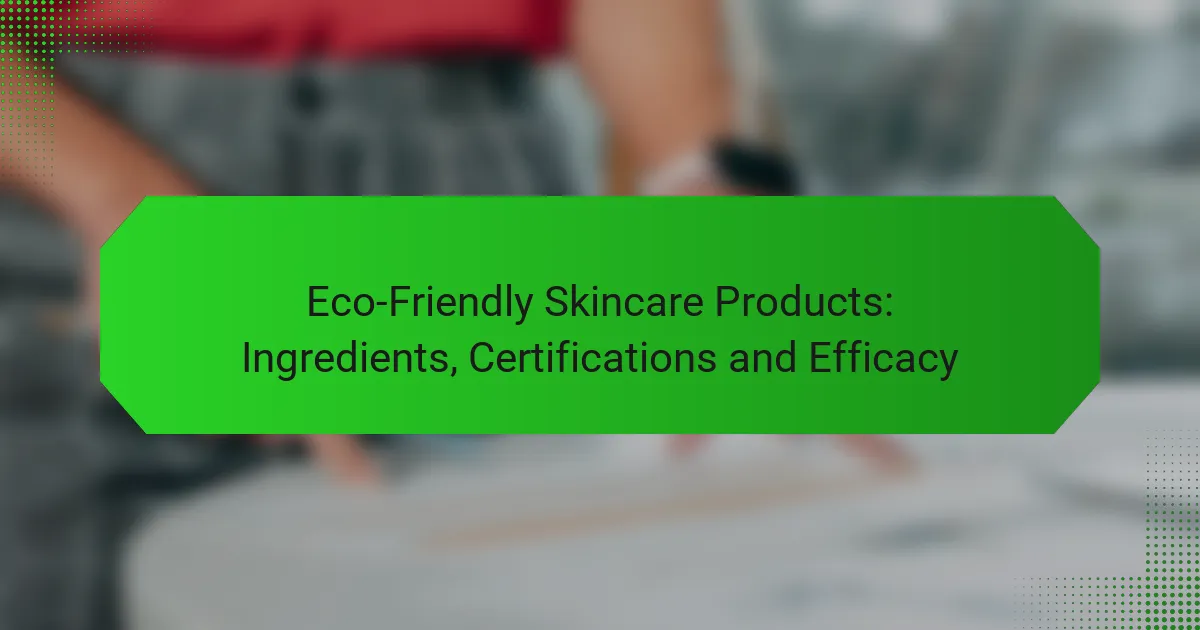Sustainable beauty brands are leading the way in the cosmetics industry by emphasizing eco-friendly practices, ethical sourcing, and innovative product development. These brands not only deliver high-quality products but also strive to minimize their environmental footprint and uphold social responsibility through fair trade sourcing and cruelty-free certifications.

Which sustainable beauty brands are leading the market?
Several sustainable beauty brands are at the forefront of the market, known for their commitment to eco-friendly practices, ethical sourcing, and innovative products. These brands not only prioritize quality but also focus on minimizing their environmental impact and promoting social responsibility.
RMS Beauty
RMS Beauty is celebrated for its organic formulations and minimalist packaging. The brand emphasizes the use of raw, food-grade ingredients that are free from harmful chemicals, ensuring that products are safe for both users and the environment.
One of their standout products is the “Un” Cover-Up, which provides natural coverage while nourishing the skin. RMS Beauty’s commitment to sustainability extends to their refillable packaging options, encouraging customers to reduce waste.
Ilia Beauty
Ilia Beauty combines skincare and makeup, offering products that are clean and effective. The brand focuses on high-performance ingredients that are ethically sourced, ensuring that their formulations are both safe and beneficial for the skin.
Ilia’s “True Skin Serum Foundation” is a popular choice, providing a lightweight feel with buildable coverage. Their commitment to sustainability is evident in their recyclable packaging and initiatives aimed at reducing carbon footprints.
100% Pure
100% Pure stands out for its dedication to using natural ingredients and avoiding synthetic chemicals. The brand offers a wide range of products, from skincare to cosmetics, all made with fruit pigments and botanical extracts.
Notably, their “Fruit Pigmented Foundation” is a favorite among consumers looking for a clean beauty option. 100% Pure also emphasizes eco-friendly practices, such as using biodegradable packaging and supporting fair trade initiatives.
Herbivore Botanicals
Herbivore Botanicals is known for its luxurious, plant-based skincare products that are cruelty-free and free from synthetic ingredients. The brand focuses on transparency, providing detailed information about the sourcing and benefits of each ingredient used.
The “Blue Tansy Resurfacing Clarity Mask” is a prime example of their innovative approach, combining natural exfoliation with soothing properties. Herbivore’s commitment to sustainability is reflected in their recyclable glass packaging and eco-conscious business practices.
Beautycounter
Beautycounter is a leader in the clean beauty movement, advocating for safer personal care products through rigorous ingredient standards. The brand offers a wide range of cosmetics and skincare items that are free from harmful chemicals, making safety a top priority.
The “Dew Skin Tinted Moisturizer” is popular for its lightweight coverage and skin-nourishing ingredients. Beautycounter also actively engages in policy advocacy to promote stricter regulations in the beauty industry, furthering their mission for safer products.

What ethical practices do sustainable beauty brands follow?
Sustainable beauty brands prioritize ethical practices that focus on social responsibility, environmental stewardship, and transparency. These brands typically implement fair trade sourcing, ensure animal cruelty-free certifications, and utilize eco-friendly packaging to align with their values.
Fair trade sourcing
Fair trade sourcing involves obtaining raw materials directly from producers who are paid fairly for their labor. This practice supports local communities and promotes sustainable farming methods, often resulting in higher quality ingredients. Brands may source ingredients like shea butter or coconut oil from cooperatives that adhere to fair trade standards.
When evaluating a brand’s commitment to fair trade, look for certifications from recognized organizations such as Fair Trade International or Fair Trade USA. These certifications ensure that the brand meets specific social and environmental criteria.
Animal cruelty-free certifications
Animal cruelty-free certifications indicate that a beauty brand does not test its products on animals at any stage of development. Brands often seek certifications from organizations like Leaping Bunny or PETA to demonstrate their commitment to ethical practices. These certifications help consumers make informed choices about the products they use.
To ensure a brand is genuinely cruelty-free, check for transparency in their sourcing and testing policies. Some brands may claim to be cruelty-free but still engage in practices that harm animals indirectly, so thorough research is essential.
Eco-friendly packaging
Eco-friendly packaging refers to materials that are biodegradable, recyclable, or made from sustainable sources. Sustainable beauty brands often use glass, recycled paper, or plant-based plastics to minimize their environmental impact. This approach not only reduces waste but also appeals to environmentally conscious consumers.
When choosing products, look for brands that clearly label their packaging as eco-friendly and provide information on how to recycle or dispose of it properly. Avoid brands that use excessive plastic or non-recyclable materials, as these contribute to environmental pollution.

How do sustainable beauty brands innovate?
Sustainable beauty brands innovate by integrating eco-friendly practices into their product development, focusing on reducing environmental impact while maintaining quality. This includes the use of sustainable materials, advanced formulations, and innovative recycling methods to meet consumer demand for ethical and effective beauty solutions.
Use of biodegradable ingredients
Sustainable beauty brands prioritize biodegradable ingredients to minimize environmental harm. These ingredients break down naturally, reducing pollution and waste in landfills. Common examples include plant-based oils, natural waxes, and organic extracts that offer effective results without synthetic additives.
When choosing products, look for certifications like USDA Organic or Ecocert, which indicate a commitment to using biodegradable and environmentally friendly components. This not only benefits the planet but also often results in gentler formulations for skin health.
Waterless beauty products
Waterless beauty products are gaining traction as a sustainable innovation, significantly reducing water usage in their production. These products, such as solid shampoos or concentrated serums, often require less packaging and have a lower carbon footprint. By eliminating water, brands can create more potent formulations that deliver effective results.
Consider trying waterless options to contribute to water conservation efforts. Look for products labeled as “water-free” or “concentrated” to ensure you are supporting brands that prioritize sustainability.
Revolutionary recycling programs
Many sustainable beauty brands are implementing innovative recycling programs to combat plastic waste. These initiatives often include take-back schemes where consumers can return empty containers for recycling or repurposing. This not only encourages responsible disposal but also fosters a circular economy in the beauty industry.
Participating in these programs can be beneficial for consumers, often providing incentives like discounts on future purchases. Check if your favorite brands offer such programs and how they manage the recycling process to ensure your contributions are effectively utilized.

What are the benefits of choosing sustainable beauty products?
Choosing sustainable beauty products offers numerous advantages, including healthier skin, reduced environmental impact, and support for ethical companies. These benefits stem from the use of natural ingredients, eco-friendly practices, and a commitment to social responsibility.
Healthier skin
Sustainable beauty products often contain fewer synthetic chemicals and more natural ingredients, which can lead to healthier skin. Many brands prioritize organic components that are less likely to cause irritation or allergic reactions.
For example, products free from parabens, sulfates, and artificial fragrances can be gentler on the skin. This is particularly beneficial for individuals with sensitive skin or specific conditions like eczema.
Environmental impact reduction
By choosing sustainable beauty products, consumers can significantly reduce their environmental footprint. These products typically use eco-friendly packaging, such as biodegradable or recyclable materials, which helps minimize waste.
Additionally, many sustainable brands focus on sourcing ingredients responsibly, often utilizing renewable resources and supporting biodiversity. This approach not only protects ecosystems but also promotes sustainable farming practices.
Support for ethical companies
Purchasing sustainable beauty products supports companies that prioritize ethical practices, including fair labor conditions and animal welfare. Many sustainable brands are transparent about their sourcing and manufacturing processes, allowing consumers to make informed choices.
By choosing these products, you contribute to a market that values social responsibility and encourages other companies to adopt similar practices. This shift can lead to broader changes in the beauty industry, promoting a culture of sustainability and ethics.

How to choose a sustainable beauty brand?
Choosing a sustainable beauty brand involves evaluating their environmental practices, ethical sourcing, and commitment to transparency. Focus on brands that prioritize eco-friendly ingredients, responsible packaging, and social responsibility.
Research brand certifications
Brand certifications can provide insight into a company’s sustainability efforts. Look for labels such as USDA Organic, Leaping Bunny, or Fair Trade, which indicate adherence to specific environmental and ethical standards.
Each certification has its own criteria, so familiarize yourself with what they entail. For instance, USDA Organic ensures that products are made from at least 95% organic ingredients, while Leaping Bunny guarantees no animal testing.
Evaluate ingredient transparency
Ingredient transparency is crucial when assessing a sustainable beauty brand. Brands should openly list all ingredients used in their products, allowing consumers to make informed choices about what they apply to their skin.
Check for brands that provide clear explanations of their ingredients, including sourcing and purpose. Avoid brands that use vague terms like “fragrance” without further details, as this can mask harmful chemicals.
Assess community engagement
Community engagement reflects a brand’s commitment to social responsibility. Look for brands that actively support local communities, whether through fair labor practices, charitable contributions, or partnerships with non-profit organizations.
Brands that engage with their communities often share their initiatives on social media or their websites. This transparency can help you gauge their genuine commitment to sustainability and ethical practices.

What is the pricing range for sustainable beauty products?
The pricing range for sustainable beauty products typically varies from budget-friendly options to premium offerings. Generally, consumers can expect to spend anywhere from $10 to over $100, depending on the brand, ingredients, and packaging practices.
Mid-range pricing examples
Mid-range sustainable beauty products usually fall between $20 and $50. Brands in this category often balance quality and ethics, offering effective formulations without the highest price tags. For instance, a well-known organic skincare line may charge around $30 for a moisturizer that uses natural ingredients and eco-friendly packaging.
Examples of mid-range sustainable beauty brands include brands like Herbivore Botanicals and 100% Pure, which provide a variety of skincare and makeup products. These brands often emphasize transparency in sourcing and production, making them appealing to environmentally conscious consumers.
When considering mid-range options, look for certifications such as cruelty-free or organic labels, which can indicate a commitment to ethical practices. This can help ensure that your purchase aligns with your values while still being accessible financially.



